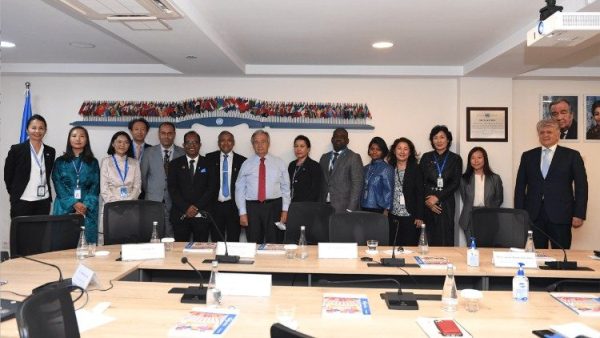Mongolia: Country of peace, model of religious cohabitation
 As Pope Francis visits Mongolia, Munkhbolor Gungaa with the UN's Industrial Development Agency highlights her country's unique geo-political position and describes how young people are emigrating, presenting a challenge to economic development.
As Pope Francis visits Mongolia, Munkhbolor Gungaa with the UN's Industrial Development Agency highlights her country's unique geo-political position and describes how young people are emigrating, presenting a challenge to economic development.
Pope Francis’ historic visit to Mongolia shines the spotlight on the East Asian country recently described as “a symbol of peace in a troubled world” by UN Secretary-General Antonio Guterres.
In an interview with Vatican News, Munkhbolor Gungaa, - or Bolor for her friends – was eager to echo Guterres’ words highlighting its geopolitical importance as it buffers China and Russia, offering a model of democracy, peace and interreligious harmony.
Regarding the Pope’s visit, Bolor, who is the National Programme Officer at UNIDO in Ulaanbaatar, said she is grateful and deems the visit “a great opportunity for Mongolia's visibility in the world.”
“The Pope’s visit is a great opportunity for Mongolia’s visibility in the world.”
Challenges in Mongolia
However, challenges are great in the young democracy, and development is crucial to curb emigration and support new generations of Mongolians in line with Sustainable Development Goals (SDGs).
As Bolor explained, UNIDO - the United Nations Industrial Development Organization - aims to promote industrial development for poverty reduction, inclusive globalization, and environmental sustainability, and she is fully committed to this effort.
"As a Mongolian person, I'm committed to the country’s development," Bolor said, explaining that UNIDO's focus in Mongolia is on the development of agribusiness, energy and environment sectors.
By integrating UNIDO’s technical expertise with Mongolia's local experience, by introducing global best practices, and by upholding the government’s vision to achieve the SDGs in line with the country’s national vision and programmes, she said she is convinced that Mongolia can also become a good role model for other countries.
For the last five years, she said, she has been working in the Agribusiness sector, which foresees upgrading technology for the textile sector, which benefits all the actors of the wool and cashmere value chains and includes projects in food safety management systems, international quality standards compliance, laboratory capacity building, leather and textile manufacturing.
Bolor pointed out that these projects support suppliers, meaning herder cooperatives, to improve their supply chain quality, improving the quality of the raw materials that are brought to the processing factories.
Thus, domestic and international market access is greatly increased and improved. All these projects, she noted, are funded by bodies like the EU and the World Bank.
“So we are supporting, under the current technical assistance, the national accreditation body, national certification bodies, government and private certification entities, as well as private sector enterprises in the meat, textile and leather sectors,” she said.
“Things are progressing and then we are looking forward to the end result by the end of the project this year.”
Motivating young Mongolians to stay
She agrees that development is one of the main priorities and challenges in Mongolia at a time in which, mainly the young generations of the traditionally nomadic population are flocking to Ulaanbaatar and a couple of other cities like Erdenet and Darkhan.
The UN official explained that almost 1.5 million people – out of a total of around 3.4 million - are living in Ulaanbaatar, “the capital city, while the city was originally designed for about 500,000 citizens.”
“Now we are overpopulated,” she added, explaining that young Mongolians are in the city seeking jobs and opportunities, but then many migrate to other countries like Korea, USA, and recently, to Australia.
“So this is also a challenge that we have only about 3.4 million people, while we have more than 70 million heads of livestock with lots of opportunities to add value to the sector.”
So, she added, there is a lack of young professionals to work in the industry, a lack of learning opportunities” and from a socio-economic perspective, salaries are lower than in other countries.
“That's why many young people are interested in moving to countries with better salaries and better living conditions and quality of life,” she said.
That’s why, Bolor continued, the high potential of the agriculture sector which is the second economic driver after the mining industry, has pushed the government to promote rural recovery and try to attract young people to stay in their hometowns and develop businesses.
A country of peace and harmony
Pope Francis's presence is putting the nation in the international spotlight. “It’s great news,” Bolor exclaimed, “that the Pope is coming to Mongolia!”
“First of all it's a great opportunity for Mongolia, Mongolia's visibility in the world and bringing global attention and interest, she said noting that the nation is “becoming more and more geopolitically important, buffering China and Russia.”
World leaders, she continued, are “now more interested in Mongolia as the country of peace as quoted by Antonio Guterres, the UN Secretary General who visited Mongolia also recently” paying tribute to its commitment to being a nuclear-free zone.
Land of the Blue Sky and religious harmony
The country itself has also a very vast territory, with beautiful nature under the blue sky, so it's attractive for international visitors to enjoy the country after the pandemic.
The visit of the Pope, Bolor added, will strengthen this opportunity to be more visible, and it will show the world that it is a country open to all religions and all cultures.
“It's also a good symbol to show Mongolian democracy and I too am looking forward to the opportunity of seeing him!”
Linda Bordoni
Source: vaticannews.va

